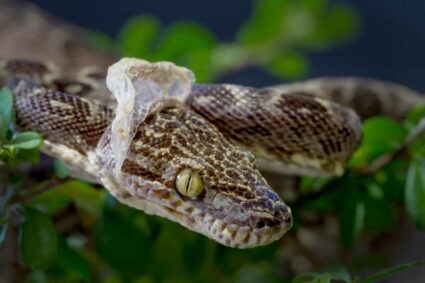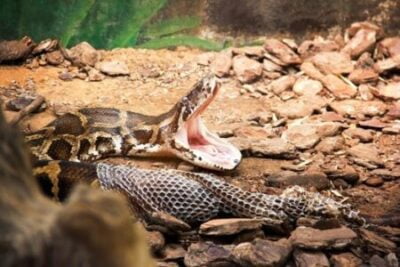Eye caps, also known as brilles or spectacles, are specialized scales that sit over your snake’s eyes. When it’s time to shed, your snake will naturally shed their eye caps along with the rest of their old skin. However, sometimes, pieces of the shed (including old eye caps) can remain.
If your snake’s eye caps won’t come off, you should raise the humidity in the vivarium. If that doesn’t work, give your snake a warm bath or place it into a damp pillowcase. The moisture should help to loosen the stuck shed. You can then try gently removing the eye caps with a moist Q-tip, a piece of tape, or your finger.
We’re going to look into the different reasons for dysecdysis (shedding problems) in snakes. You’ll find out what dysecdysis is, what causes it, and how you can tell if your snake’s eye caps are stuck. We’ll then explain how you can remove your snake’s stuck spectacles safely.
What Is Dysecdysis in Snakes?
Snakes shed all of their skin in one go. When they’re done, you should see one long piece of dead skin with no holes or missing parts.
Your snake’s eye caps are clear, round scales that cover the eyes. They are also known as ocular scales, brilles, or spectacles. As snakes don’t have eyelids, these eye caps protect the cornea from dirt and physical harm. A snake’s spectacles also prevent the eyes from drying out.
Shedding doesn’t always go to plan, often due to a lack of humidity. A problem shed that leaves bits of skin stuck on your snake is called dysecdysis. The most common symptom of this is retained eye caps.
Like every other scale on the snake’s body, the eye caps must be shed every 3 to 6 months and replaced with new ones. When dysecdysis occurs, the old spectacles can remain stuck on your snake’s eyes.
If left the eye caps aren’t shed properly, this can lead to inflammation or a bacterial infection of the eyes, according to Veterinary Pathology.
What Causes Stuck Shed in Snakes?
Retained eye caps could be due to illness or disease, but it’s usually down to poor husbandry or suboptimal conditions for your species of snake. Here are some of the most common explanations for dysecdysis:
Lack of Humidity
By far the most common cause of a stuck shed, including retained eye caps, is insufficient humidity in your snake’s vivarium.
All snakes require a certain level of humidity in order to stay healthy. The amount of humidity will depend on the species of snake you keep.
| Corn snake: | 40-60% |
| Ball python: | 55-60% |
| Burmese python: | 50-70% |
| Green tree python: | 80-90% |
| Kingsnake: | 40-60% |
| Milk snake: | 40-60% |
If the humidity level in your vivarium does not reach the minimum for your snake’s species, this can result in dehydration. In fact, the humidity level should be slightly higher to facilitate the shedding process.
Lack of Rough Surfaces
Snakes require at least one rough surface in their vivarium. This could be a wooden hide box, a rock, a log or some kind of decoration.
The snake will use this to nudge their nose up against, to tear a hole in its old skin and start the shedding process.
If you keep your snake in a smooth glass-walled vivarium with nothing but a round plastic water bowl and hide, it may struggle to get its shed started.
Fed The Wrong Foods
Most species of snake fare best when fed what they eat in the wild. Colubrids, such as corn snakes, survive on a diet of mice and rats. Rodents contain sufficient calories, macronutrients, and micronutrients to keep your snake in optimal condition.
If your snake hasn’t been eating correctly, either because you’re feeding it the wrong food types or not enough, this can result in dysecdysis. Poor nutrition can cause many other health problems in snakes.

Parasites or Illness
Ectoparasites, parasites that live on the outside of your snake’s body, can also lead to problems shedding. Snakes that are infested with mites or ticks often struggle with dysecdysis as one of their symptoms.
Dysecdysis can also, in rarer circumstances, indicate the presence of an underlying disease or health condition. For example, dysecdysis can be a symptom of inclusion body disease in boas and pythons, according to the American Society for Microbiology.
Symptoms of Retained Eye Caps
Start by checking the shed skin itself. At the head end, you should notice two clear, circular scales where the eye caps would be.
No sign of the eye caps anywhere would suggest that your snake has retained them. Examine your snake’s eyes, paying attention to:
- The texture of the eye. The eyes should appear round and plump. Look for any dimpling or wrinkles on the surface area.
- The color of the eye. If your snake has retained eye caps, its eyes may look grey and foggy. Retained eye caps have an opaque sheen to them, while healthy eyes are dark and clear-looking.
- The scales around the eye. Retained eye caps may be accompanied by dried skin in the groove between the eye and the surrounding area.
How to Remove Your Snake’s Stuck Eye Caps
There are four things you can do to help your snake’s eye caps come off:
Increased Humidity
A humidity level that is optimal for your species of snake is essential. By increasing the humidity level in your snake’s vivarium, a snake’s retained eye caps may come loose. Here are some ways that you can do this:
- Get a reliable humidifier for your snake’s tank.
- Adding an extra water dish into the vivarium or move the existing water dish to the warm end of the enclosure
- Mist the inside of the enclosure with water once per day, including the sides, decorations, and your snake’s body.
- Add a humidity box. This is a small plastic tub, large enough for your snake to curl up inside, with an entrance hole cut out of the side. Fill the tub with damp sphagnum moss, or damp paper towels.
Soak
The moisture and steam from the warm water add to the humidity inside your snake’s enclosure. Also, snakes enjoy bathing in warm water. This helps to soften a snake’s skin and get rid of parasites, such as mites.
Use a large plastic tub with air-holes cut into the lid, and fill it up to chin-height for your snake. The snake should be able to poke its head out of the water to breathe. The water should be 85 to 90 degrees Fahrenheit.
Place your snake into the tub and allow it to soak for 15-20 minutes. Afterwards, you’ll notice that the snake’s skin is softer. Gently run a damp washcloth over the snake and its eye caps should come off more easily.

Use a Damp Pillowcase
Take a clean cotton pillowcase and soak it in warm water, the same temperature that you used for the bath. Wring the pillowcase out so that it remains damp, but isn’t dripping wet. Then, place your snake inside it. Secure the end with a clip, hair tie or string, so that your snake can’t get out.
Place the pillowcase, with your snake inside, into a plastic tub. Your snake will naturally move around inside the pillowcase, pressing its body up against the damp cloth. This will loosen any stuck shed. After about 20 minutes, take your snake out and carefully dry it off.
Remove the Eye Caps Manually
If the ‘spectacles’ are still present, you can remove them manually. Here are some ways to remove stuck eye caps:
- Moist Q-tip. Either soak the Q-tip in warm water or add a dab of petroleum jelly. Gently rub it against the eye to coax the eye cap away, while holding your snake still with your other hand.
- Masking Tape. Press a piece of masking tape to the eye cap and pull it away. The eye cap may stick to the masking tape and come away.
- Rubbing. Wearing a disposable latex finger cot to create some traction, use your finger to rub the old eye cap away.
- Peeling. You can carefully peel away the layer of dead skin.
Do not attempt any of the above if you don’t feel comfortable, or you aren’t sure whether the old spectacles are still there. A vet can assist.


I have a 6-7 month old ball python. His had had trouble shedding due to his previous owner having him in a tank with poor humidity and cedar chips. His last she’d it seems like his eye cap got stuck. So I soaked him in a container and did the warm bath and tried the q-tip rubbing too and thE warm cloth To help the humidity as well. I take him to the pet shop with me when I get his frozen mice. He had a small piece of stuck shed on the side of his mouth. The reptile worker at the shop tried rubbing it off and when I brought him and his food back home. My his and and I noticed his eye was really dry looking and sunken in. With light near his eye you can still see the color and he can still see movement there but I’m scared to think he may be losing his eye sight in that eye. Cause when he gets his warm baths it comes out like his other eye but when he is not soaked his eye is sunken in some but he is very healthy over wise and active and loves to be held. Any help to know what it is would be appreciated. Thank you. Love this lil guy like I do our other pets and kids.
As well as a sight bleeding in two small spots but it dosent do that anymore